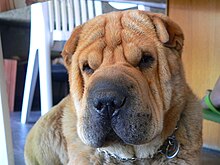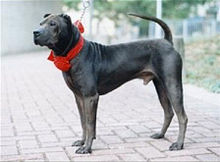Shar Pei
The Shar Pei, or Chinese Shar-Pei, is a breed of dog known for its distinctive features of deep wrinkles and a blue-black tongue. The breed comes from China. The name (沙皮, pinyin: shā pí; English name probably derived from British spelling of the Cantonese equivalent, sā pèih) translates to "sand skin" and refers to the texture of its short, rough coat. As puppies, Shar Pei have numerous wrinkles, but as they mature, these wrinkles loosen and spread out as they "grow into their skin". Shar Pei were named in 1978 as one of the world's rarest dog breeds by TIME magazine and the Guinness World Records. The American Kennel Club did not recognize the breed until 1991.
Appearance
Small, triangular ears,and a high-set tail also give the Shar Pei a unique look. For show standard, "the tail is thick and round at the base, tapering to a fine point" (AKC standard February 28, 1998). As puppies, Shar peis are a lot more wrinkly than adults and, although some adults can be wrinklier than their puppy self, an adult pei should have wrinkles mostly on the face, a few on their shoulder and at the base of the tail. A muzzle shaped like hippopotamus (hippo).
Colors
Their pigmentation resemble the Chow Chow as they've been crossed before, probably giving them the same blue-black tongue. There are over sixteen recognized colors in AKC. The coat must be solid in color, and any Shar-Pei with a "flowered coat" (spotted) or black and tan in coloration (i.e. German Shepherd) is a disqualification. Colors include black, blue, cream, fawn, red-fawn, red, sable, apricot, chocolate, and isabella. The nose may be black or brick (pink with black), with or without ablack mask. A Shar-Pei can also have what is called a "dilute" coloration. Meaning the nose, nails and anus of the dog is the same color as the coat, (i.e. chocolate coat with chocolate nose, nails and anus). All of these color variations are acceptable and beautiful, but the coat color must be solid and well blended throughout the whole body of the dog,
Coat
Western Shar Pei comes in three different coat types: horse, brush, and bear coat. The unusual horse coat is rough to the touch, extremely prickly and off-standing and is closer to the original traditional Shar Pei breed in appearance and coat type than the brush or bear coat. This coat is fairly prickly and can be rough or irritating when petting in the opposite direction of the fur. The horse coat is generally thought to be more active and predisposed to dominant behavior than the brush coat. The brush-coated variety have slightly longer hair and a smoother feel to them. The brush coat is generally considered to be more of a "couch potato" than the horse coat.
The Chinese Shar-Pei is a unique and intelligent dog most often recognized for its wrinkles. Initially developed as a Chinese farm and hunting and later fighting dog, the breed does well today in obedience, agility, herding and tracking, with skills that would have been needed on the farm. Because the name Shar-Pei means "sand coat", harshness is a distinctive feature in its two accepted coat types, either horse (short) or brush (up to an inch long). Other unique qualities include black mouth pigment, a slightly "hippo-like" head shape, small ears, deep-set eyes and rising top-line.
Any coat longer than one inch at the withers is called a "bear coat" and is not considered breed standard, as it only occurs when both the male and female carry recessive coat genes. This coat length resembles the coat of the Chow Chow and was probably inherited from the chows. The personality of the bear coat is very much like that of a brush coat.
Wrinkles
There is a type of Shar Pei called "traditional" that is most popular in China and that is more faithful to the history of the breed (taller, less wrinkly, flatter mouth and nose, horse coated). As puppies, they have lots of wrinkles and as they get older, they get fewer wrinkles.
Scientists from the Department of Genome Sciences at the University of Washington, Seattle, announced in January 2010 that they had analysed the genetic code of 10 different pedigree dog breeds. In the Shar-pei they discovered four small differences located in the gene HAS2 which is responsible for making hyaluronic acid synthase 2. That enzyme makes hyaluronic acid, which is one of the key components of the skin. There have been rare cases in which a mutation of the same gene has caused severe wrinkling in humans as well.[3]
Temperament
All Shar-Pei puppies need early socialization with children, strangers, and other animals. Like other fighting breeds, they can be stubborn, strong-willed and very territorial. Early training can help control these traits before they become problem behaviors. Some people may experience a sensitivity to the harshness of the coat of either length. This is a mild, short-lived rash that can develop on the skin that has been in contact with the coat, most commonly on the forearms.
The Shar Pei is often suspicious of strangers, which pertains to their origin as a guard dog. It is a very independent and reserved breed. Nevertheless, the Shar Pei is extremely devoted, loyal and affectionate to its family and is amenable to accepting strangers given time and proper introduction at a young age. If poorly socialized or trained, it can become especially territorial and aggressive. Even friendly and well-socialized individuals will retain the breed's watch dog proclivities (like barking at strangers). It is a largely silent breed, barking only when it is playing or worried. The Shar-Pei were originally bred as palace guards in China. The breed is amenable to training but can be very stubborn. With repetition and a clear reward system, training is not very difficult. Overall, the Shar Pei can be a dog that is loyal and loving to its family while being very protective and independent.
History
The Shar Pei breed comes from the Guangdong province of China. The original Shar-Pei from China looked very different from the breed now popular in the West. People in southern China, Hong Kong, and Macau differentiate the Western type and the original type by calling them respectively 'meat-mouth' and 'bone-mouth' Shar-Pei.
The ancestry of the Shar-Pei is uncertain. It may be a descendant of the Chow Chow; however, the only clear link between these is the blue-black tongue. However, pictures on pottery suggest the breed was present even in the Han Dynasty (206 BCE). A statue on display at the Boston Museum of Fine Arts dating from the second century C.E. depicts a dog that strongly resembles a modern Shar Pei. For many years, the Shar-Pei was kept as a general-purpose farm dog in the Chinese countryside, used for hunting, protecting and herding stock and guarding the home and family. During that time, the Shar-Pei was bred for intelligence, strength and scowling face. Recent genetic research has suggested the Shar-Pei is one of a few ancient dog breeds, believed to have split from common ancestors earlier than other breeds. By mapping subtle differences in each breed’s genes, searching for patterns of relationships and designing a tree to fit them, they could finally gain insight into this marvel of evolutionary engineering. In 2004, the foundational analysis of purebred dog genetics was published in Science[citation needed]. The resulting tree was profoundly asymmetrical. After wolves, just four groups sat its base: Asia’s shar-pei, along with shiba inu, akita and chow chow; central Africa’s basenji; malamutes from the Arctic, along with Siberian huskies and samoyeds; and from the Middle East, Afghan hounds and salukis.
Later, it was used for dog fighting. The loose skin and extremely prickly coat were developed originally to help the Shar Pei fend off wild boar, as they were used to hunt. Dog fighters used these enhanced traits to make the Shar-Pei difficult for its opponent to grab and hold on to, and so that if it did manage to hold on, the Shar-Pei would still have room to maneuver and bite back. The Shar-Pei's most intriguing feature, in this respect, is that if one grabs them by any loose wrinkle, they can actually twist in their skin and face in one's direction. This trait was used in fighting as a means for them to fight back; they would be bitten and twist in their skin to bite back at the offender. During the Communist Revolution, when the Shar Pei population dwindled dramatically, dogs were rescued by a Hong Kong businessman named Matgo Law, who appealed to Americans in 1973 through a dog magazine to save the breed. Around 200 Shar-Peis were smuggled into America. The current American Shar Pei population stems mainly from these original 200.
 | |||||||||||||||||||||||||
| Other names | Chinese Shar-Pei | ||||||||||||||||||||||||
|---|---|---|---|---|---|---|---|---|---|---|---|---|---|---|---|---|---|---|---|---|---|---|---|---|---|
| Country of origin | China | ||||||||||||||||||||||||
| Patronage | F.C.I.[1] | ||||||||||||||||||||||||
| |||||||||||||||||||||||||
| |||||||||||||||||||||||||






No comments:
Post a Comment